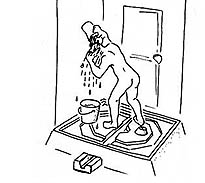
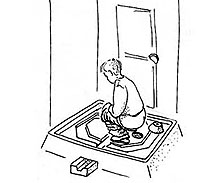
why
This is about the construction of a Bathroom Toilet units at affordable costs. It aims at an improvement of sanitation in a rural setting. This method is meant to be used in a communal project where inhabitants of a village can be motivated to build a private bathroom for every family around. To achieve that every family can work on its own bathroom facility at the same time, while sharing experience and guidance, a special construction method is used.
how
Properties of the BathroomToilet-unit
- A comfortable space for bathing, also to be used for sanitation, nice looking, decorated, easy to clean,
- Sufficient space for a parent to bath a small child and to teach it the proper use of a toilet.
- Waste water from bathing rinses urine away, minimizing stink and use of flush water.
- The bathroom/toilet unit can be configured as a composting toilet or to dry-fill a dug out.
- The cost of the bathroom/toiltet unit is only the cost of one bag of cement. The work can be done by the adults and children of each family with guidance from an instructor.
- MOST IMPORTANT, the method of construction is adjusted to a communal project. With some guidance of sanitation helpers (like WaterAid) the local carpenter makes a true scale model in wood of the toilet slab, gutter and other parts. Everybody can imagine what it will be like when later copied in concrete. With a special but simple trick an accurate impression or mold of the slab can be made into the dirt. Then concrete with some reinforcement is cast into the mold. Two such slabs and a gutter make one toilet. Personal decoration of the slabs is done by putting colored stones or bits of tiles in the mold before the concrete is poured over it.
- MOST IMPORTANT, with the one wooden model of the slab all the cast forms for all the families around can be made within a few weeks.Thus ALL the families then own a private bathroom sanitation unit of high quality.
- When ALL the families in a neighbourhood use their own toilet this results in far less illness, specially for children. If only a small part of the total number of families would be left out, this life-saving health improvement could not be attained.
- How to instruct the user of the bathroom with toilet?
It is not clear how users should best be instructed of how to use the toilet. The following options are considered:
- Children are instructed at school (preferably the local school takes the lead with improving sanitation).
- At home it is the task of the mother to instruct and guide the children and female visitors.
- It is the task of the man at home to instruct male visitors. He should supervise the proper hygienic condition of the toilet. When the feces is to be composted, he should take care in time of changing from the use of the one container to the other.
- If feces is not reused, he should plan in time to dig a new pit and plan the move of the bathroom-toilet unit to this new site.
The BathroomToilet-unit was used like this for many years at Demotech's own workshop.
With wooden copies of the final concrete parts quickly imprints in most soil can be made in or near the yard of every family. These imprints serve as a mold to cast the concrete in for the parts needed. Work in a village for this project is split up in eight parts:
- Making the two wooden copies of the concrete parts of the bathroom/toilet, the slap and the gutter
- Making two imprints with the wooden slab-copy in the dirt
- Making one imprint with the gutter-copy in the dirt
- Adding concrete to the imprint of the slab: line with paper or plastic, add concrete, reinforce, compact and finish
- Adding concrete to the imprint of the gutter: line with paper or plastic, add concrete, reinforce, compact and finish
- Preparing for composting: build the sub-structure with two cellars under the slabs
- Or preparing for a temporary pit top construction that can be moved when the pit is full
- Finalizing the Bathroom Toilet unit and to take it into use
Making the two wooden copies of the concrete parts of the bathroom/toilet, the slap and the gutter
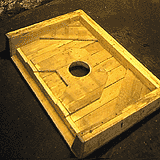
First comes the construction together with the local carpenter and its helpers of the molds to shape the concrete parts. In fact they are replica in wood of the later to be cast concrete parts.
Making two imprints with the wooden slab-copy in the dirt
With the woodencopy of the slab two imprints are made with moist dirt. With the latest working method, the top of the slap with its face up, is covered with dirt, that is made flat and compacted. Then the slap is quickly turned over with its face down. Moist dirt is then compacted around the wooden copy to form the sides of the imprint. Finally with great care the wooden copy is lifted off the imprint. Often little repairs are needed of the imprint, this can be done with mud and something flat.
Making one imprint with the gutter-copy in the dirt
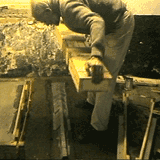
The imprint of the gutter is made in the same way. Again the top of the wooden copy can be filled with dirt that is compacted and flattened. Then the gutter-copy is turned over. Dirt is compacted against the sides of gutter copy, then it is lifted off. Realize these imprints are easily demaged. Keep small children, goats and dogs at a distance. Also keep moist, cover it to protect it against sun and rain. Best is to continue immediatelly with casting concrete.
Adding concrete to the imprint of the slab: line with paper or plastic, add concrete, reinforce, compact and finish
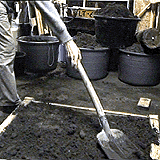
Prepare concrete that is like moist mud, not like watery mud. To achieve this, while mixing add water only with small bits. Before adding concrete cover the surface of the imprint in the mud with oiled paper. This prevents the cement water to seep away in the mud. The concrete is reinforced with scrap.
Adding concrete to the imprint of the gutter: line with paper or plastic, add concrete, reinforce, compact and finish
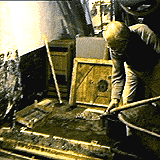
The same method applies for adding concrete to the imprint for the gutter. When adding scrap to reinforce the concrete, take care that these bits of wire or sheet metal are not pushed in too hard, that they stick through the concrete into the dirt of the imprint. All concrete casts shoud get ample time to set and harden. In the mean time keep them wet and prevent damage by animals.
Preparing for composting: build the sub-structure with two cellars under the slabs
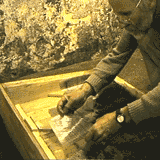
With the two slabs and the gutter ready for assembly it is easier to decide where the actual place of use will be situated, in the house or near it. Now it has to decided whether to compost the excreta or to collect them in a deep pit. A double composting cellar is known from sanitation projects in Vietnam and India. A drain has to be made for the water used in the bathroom, also containing the urine of its users. This spill water could also be collected as fertilizer. It contains essential agricultural nutricians. However, then stink caused by open collection of urine has to be prevented.
Or preparing for a temporary pit top construction that can be moved when the pit is full
If composting human excreta is not pracital or acceptable for the future users, the Bathroom/Toilet can be assembled over a deep pit. Spil water from the Bathroom/Toilet can best be guided to a sink and not directly into the pit. This will reduce stink coming from the pit. Prevent the pit to be dug into groundwater for the same reason. Do not dig a pit close to a water well.
Finalizing the Bathroom Toilet unit and to take it into use
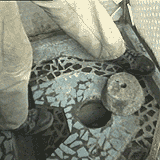
A neat separation has to be made around the slabs and gutter assembly. The entrance is best in the middle, above the gutter. The opening in the slab for defecation can best be closed with a concrete block, such as also used in the procedure of casting the slabs, see picture. Make sure future users get proper instruction how to use the toilet. Template:Demotechpage